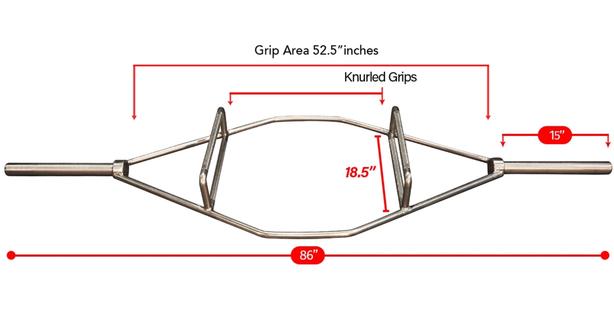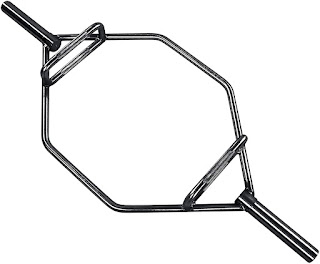What is a trap bar?
A trap bar, also known as a hex bar, is a piece of weightlifting equipment that looks like a hexagon. It is used for exercises that require the lifter to stand in the middle of the bar, rather than grabbing from behind it with their hands.
How much does a trap bar weigh when empty?
The weight of a trap bar can vary depending on the model and brand. However, most models typically weigh around 45 pounds.
This is heavier than a regular barbell bar but there is a lot more to the structure in terms of materials. The bar also needs to be made of high-quality materials with high-quality welds in order to handle extreme loads. This all adds to the weight of the bar.
How do you add weights to a trap bar?
Most trap bars will have Olympic-sized weight plates. This means that you can add the same type of weights that you would use on a barbell.
The process is the same, simply slide the weights onto each end of the bar until it is at your desired weight. Once you have your plates in place, slip on the collars so that they can't fall off.
It is a good idea to use a low rack when loading the bar to make it easier. especially if you are using heavy plates.
How do you use a trap bar?
Trap bars can be used for many different exercises. Some of the most popular exercises that require a trap bar are deadlifts, squats and shrugs. The benefits of using a trap bar include increased stability, improved range of motion, and less stress on the joints.
Exercises that require a trap bar:
Deadlifts are probably the most used exercise for a trap bar. Using a trap bar allows you to keep your spine in a more neutral position, which takes stress off of your lower back.
Squats can also be done with a trap bar, and this allows you to keep your torso more upright, which again takes stress off of your lower back.
Shrugs are another great exercise for a trap bar. This exercise works the muscles in your upper back and can help to improve your posture.
Calf raises are the last exercise that I will mention that can be done with a trap bar. This exercise is great for building strong calves.
There are many other exercises that can be done with a trap bar, but these are just a few of the most popular ones.
What are the best options for buying a Trap bar?
Cheapest - HulkFit Olympic 2-Inch Weight Lifting Trap Bar.
This is one of the cheapest bars on the market and offers incredible value for money. It is a solid steel bar capable of handling loads up to 1000lbs. If you can lift more than that, you are going to have to spend big!
There are a couple of bars that are slightly cheaper but none of them has the same solid construction or weight handling capabilities.
The Hulkfit Trap Bar weighs 45lbs which is at the lower end as trap bars go making it great for beginners and intermediate lifters.
The 2-inch bar is made for Olympic plates or 2-inch bumper plates which are the standard size.
Best Quality - APJJ Olympic Trap Bar
Is the trap bar the same as a hex bar?
The trap bar and the hex bar are very similar but there are some slight differences.
The most noticeable difference is the shape of the bars. A trap bar has handles that come out at an angle from the sides of the bar, whereas a hex bar has handles that come out straight from the top and bottom.
This means that a trap bar is easier to grip when performing exercises such as deadlifts and shrugs.
Another difference is that a hex bar is slightly longer than a trap bar, which can make it more difficult to store.
Finally, the weight of a hex bar is usually evenly distributed, whereas the weight of a trap bar is often slightly heavier at the ends.
This is because the weight of the bar is taken into account when designing a trap bar, whereas the weight of a hex bar is not.
In general, both bars are suitable for a wide range of exercises and it is up to personal preference as to which one you use.
Trap bars are more popular for deadlifts and shrugs, whereas hex bars are more popular for squats and lunges.
Whichever bar you choose, make sure that it is of good quality and that it is the right size for you.
The Benefits of Using a Trap Bar:
Trap bars offer many benefits, including increased stability, improved range of motion, and less stress on the joints.
Improved range of motion is especially beneficial for exercises such as deadlifts and squats. When using a trap bar, you are able to keep your torso more upright, which allows for a greater range of motion. This can lead to better results and less stress on your body.
Trap bars are also beneficial because they offer increased stability. This is especially helpful when you are doing exercises such as deadlifts and squats. The hexagon shape of the trap bar allows you to keep your feet in a more stable position, which can help you lift more weight and avoid injury.
Lastly, trap bars offer less stress on the joints. This is because they allow you to keep your spine in a more neutral position. This takes stress off of your lower back and can help to prevent injuries.
The Negatives of Using a Trap Bar:
There are some negatives to using a trap bar, but they are not major.
One negative is that they can be more expensive than other types of weightlifting equipment.
Another negative is that they are not as widely available as other types of weightlifting equipment. This means that you may have to order one online or travel to a speciality store to find one.
The last negative is that they are not as versatile as other types of weightlifting equipment. This means that you may not be able to do as many exercises with a trap bar as you could with a standard Olympic bar.
Overall, the positives far outweigh the negatives when it comes to using a trap bar.
Conclusion:
In conclusion, the trap bar is a great piece of equipment for those looking to improve their strength and size. It offers many benefits, including increased stability, improved range of motion, and less stress on the joints. While it may be more expensive than other types of weightlifting equipment, it is worth the investment.
I hope this article has helped you learn more about the trap bar and how to use it. If you have any questions, please leave a comment below.
Happy lifting!
FAQ's
Why do trap bars weigh so much?
The weight of a trap bar can vary hugely depending on the quality, model and brand. Most models weigh around 20kgs (45 lbs) so they are quite heavy in comparison to other bars. This is because there is a lot more to their structure.
If a trap bar feels too light, it is probably of low quality and will not be able to handle the weights required for heavy deadlifts or shrugs.
Are all trap bars a standard size?
Most trap bars are a standard size, however, there can be some variation. The standard size for a trap bar is usually around 48 inches (122cm) in length and 24 inches (61cm) in width.
Some companies make smaller or larger sizes to accommodate different sized athletes.
What weight should I use for a trap bar deadlift?
The weight you use for a trap bar deadlift will depend on your experience level, strength and fitness goals.
If you are new to lifting, start with a light weight and gradually increase the amount of weight you lift as you get stronger.
What weight plates do I use with a trap bar?
You can use any weight plates that you have with a trap bar. The most common types of weight plates are Olympic plates, which have a two-inch hole in the centre.
You can also use bumper plates, which are made of rubber and have a raised lip around the edge to prevent them from sliding off the bar.
Some cheaper trap bars only have 1-inch holes and these are designed for cheaper weight plates. These bars will bend easily if used with a heavy load.
If you train with heavy weights or are aspiring to do so, invest in a 2-inch bar and some Olympic plates.
Do I need a special rack for a trap bar?
No, you do not need a special rack for a trap bar. You can use any weightlifting rack that is able to accommodate the size of the bar.
Most power racks and squat racks will be able to hold a trap bar. If you do not have a rack, you can just load it from the floor.
How do I store a trap bar?
To store a trap bar, simply place it on the floor or on a weightlifting rack. Make sure that it is in a safe and secure location so that it does not fall over and injure someone.
The shape of a trap bar makes it a tricky one to stand up against a wall securely but it will hang well on wall brackets.
You can also buy special storage racks for trap bars. These are not necessary but can be helpful if you have multiple bars or other weightlifting equipment that you need to store.
Should I use lifting straps with a trap bar?
Lifting straps are not necessary when using a trap bar but they can be helpful if you are lifting very heavy weights.
Straps will help you to grip the bar more securely and prevent your hands from slipping.
If you are performing heavy deadlifts, shrugs or calf raises, it is advisable to use lifting straps so that you can focus all of your attention on the target muscles without being concerned about holding on to the bar.
Your grip will usually give up long before your traps, quads, glutes or calves!
If you use lifting straps, make sure that they are of good quality and that you know how to use them
Can I use a trap bar for pressing?
Yes, you can use a trap bar for pressing movements such as shoulder presses, bench presses and overhead presses.
The weight of the bar will add resistance to the movement and help to build upper body strength.
Make sure that you have a good grip on the bar before you start lifting and that the bar is securely positioned on your shoulders, upper back or chest.
Using a trap bar for pressing exercises is a great way to add variety to your training and work different muscle groups.







.png)




